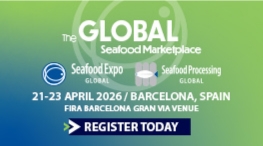Liivi Lahe Kalanduskogu (Association of fisheries of the Gulf of Liivi)
This article was featured in Eurofish Magazine 4 2025.
The fishery for Baltic herring on the Pärnu Bay is compressed into a two-month season where teams of fishers go out in two vessels, one for transport and the other a smaller support vessel, to empty their trap nets. The fish is brought back to shore loaded into tubs and delivered to processing facilities within a few hours.
In Estonia’s Pärnu Bay, on the Gulf of Liivi, the spring season marks a period of intense but short-lived activity for local coastal fishermen. Every year, from April to early June, hundreds of fishermen converge on the bay to catch Baltic herring—a species that has long supported the livelihoods of coastal communities. This is a fishery defined by seasonality, tradition, innovation, and community, as described by Ms Esta Tamm, head of the NGO Liivi Lahe Kalanduskogu (Association of Fisheries of Gulf of Liivi), during an interview conducted aboard a working vessel during the 2025 season.
A seasonal fishery rooted in tradition
Coastal fishing in the Gulf of Liivi is centred around trap nets, a passive form of fishing gear placed in traditional locations close to shore. Most of these locations are inherited, passed from father to son or acquired informally through community ties. These trap nets are only used during the herring season in spring when cold water ensures high quality. Warmer temperatures degrade the fish’s condition quickly, making it unsuitable for consumption or sale. The trap net system, typically composed of a 600-metre-long leading line and a catch box of approximately 35 by 12 metres and six metres deep, relies on the natural movement of herring into the net corridor. Once inside the box, the fish are unable to escape. Nets are spaced at least 300 metres apart and placed in shallow coastal waters—often around 10 metres deep in the Pärnu Bay area, locations that have remained consistent for decades.

Margus Post, the captain of the vessel, is one of the first coastal fishers to install a pump to transfer
the fish from net to boat, an innovation he is very satisfied with as it reduces manual handling and is faster
and less demanding than transferring the fish by hand.
The Association of Fisheries of Gulf of Liivi has around 100 professional fishermen who are members of the Association in the Pärnu region, although the number of people involved in coastal fishing extends well beyond this. According to Ms Tamm, the total number of coastal fishers in the region is around 380. The NGO functions as a support body facilitating coordination, quota management, and advocacy. The fishery is not cooperative in structure. Fishermen typically operate independently or in small teams of five to eight members. These brigades may be family units or ad hoc teams formed for the two-month season. Despite the lack of formal cooperatives, informal networks and shared knowledge help the community manage resources and labour efficiently.
Regulation and quotas
The Baltic herring fishery is governed by national quotas, which allocate a set amount of allowable catch per trap net. Fishing activities are regulated both by quotas (such as for herring) and by the presence of several designated areas in the bay (e.g., sailing and surfing zones) where fishing is either prohibited or allowed only under time restrictions and specific agreements, says Ms Tamm. Additionally, we operate under a fishing rights system, which is allocated to fishermen in the Pärnumaa region. This means each fisherman has a defined number of fishing gear units. Not all fishing gear is used at the same time. Since the Pärnu River is also salmon river, this also imposes both temporal and spatial restrictions on fishing activities. Baltic Herring, however, is the most important species in terms of volume. Fishing takes place up to the 20 m depth contour from the coastline. The Pärnumaa fisheries area to which the Gulf of Liivi belongs accounts for some 70% of the total Estonian coastal fishing volume. In 2025, each net was allowed to catch between 40 and 42 tonnes of herring. The total number of trap nets in the region was about 145, making the aggregate -seasonal -capacity substantial. This quota system replaced the earlier “Olympic” method of open competition, which forced fishers to catch as much as they could until the quota was exhausted. The new system reduces overfishing and allows for more humane working hours. Allocation of nets is traditionally determined by familial inheritance or personal purchase, with no centralised or commercialised market. Because these nets are valuable and offer the potential for significant short-term income, they are considered a major asset. A significant share of the Baltic herring catch goes to processing rather than direct human consumption. One prominent figure in the fishery owns both the fishing operation and a processing facility managed by his daughter. The company specialises in producing pet food, ensuring that most of the catch
is utilised.

Emptying the net calls for a team of eight to ten people in a second vessel who gather the catch
next to the main vessel to facilitate the transfer to the hold.
Innovative technology is slowly making its way into the fishery. One notable advancement is the adoption of a pump system to transfer fish from nets to boats, significantly reducing manual labour. Developed locally and first deployed during the 2025 season, this pump allows a single vessel to load several tonnes of fish more quickly and with fewer workers. Though costly, this innovation may receive EU funding under programmes supporting sustainable fisheries infrastructure. First sale of the catch does not occur through a formal auction but rather through -arrangements between fishers and producer organisations or direct buyers. Trucks wait at the harbour to transport the catch to processing sites immediately, reducing the time between catch and handling. Some fish is sold directly to consumers at harbours, especially during events like Open Harbour Day at the end of April.
A diverse but challenging livelihood
Although Baltic herring is the primary catch during spring, local fishermen also target perch, pike-perch, smelt, and round goby at other times of the year using different gear such as gillnets. Perch and pike-perch, in particular, are more valuable per kilogram, often fetching €3 to €6, compared to €0.35 for herring. However, catches are more limited and require year-round effort. Most fishermen (around 90%) do not rely solely on fishing for income. Many diversify into agriculture, horticulture, forestry, bee keeping, fish processing, or -construction outside the Baltic herring season. Some participate in EU-funded mobility and training programmes. The demanding nature of the job, combined with its -seasonal structure, discourages many young people from entering the profession full time.

If the catch is good the boat will sail back to the harbour after emptying a single net,
otherwise it moves on to the next.
The sector faces environmental pressures as well. Seals and cormorants increasingly compete with humans for fish and damage fishing gear. Ms Tamm notes that Estonia had over 44,000 nesting pairs of cormorants in 2024, and fishermen regularly report gear loss or destruction caused by seals. These factors add operational risk and affect the yield sometimes leaving fishers with just a third of the catch with the rest either eaten or damaged so that it is unfit for human consumption. She feels the state of fish stocks depends largely on external factors, such as the predators while fishers carry out their activities in a responsible and sustainable way. Catches are recorded and reported with an electronic logbook, which most, though not all, fishers are satisfied with as the system does not function as well as it should, says Ms Tamm. Older fishers tend to struggle with the system too, and so the ministry has enabled authorised people to enter the data on their behalf.
Sustainability and cultural legacy
Despite the challenges, the fishery remains stable. The number of trap nets has remained consistent over decades, and local fishermen observe that the catch levels have not declined significantly. Passive fishing methods like trap nets exert relatively low environmental pressure compared to trawling, and their selectivity reduces bycatch. The fishery is also deeply rooted in local culture. Coastal villages owe much of their historical development and economic survival to spring herring fishing. Homes were built with the income from successful seasons, and local customs, including food traditions and community festivals like the smelt festival and Open Harbour Day, are intertwined with the fishery.
Ms Tamm and others involved in the fishery reflect a strong sense of identity tied to the sea. Young fishermen speak of their pride in maintaining family traditions, even as they seek other careers or balance fishing with modern education and travel opportunities. The fishery not only sustains livelihoods but also helps maintain coastal communities’ cohesion and resilience. Supported by organisations like Liivi Lahe Kalanduskogu and connected to national and EU programmes, the fishery has managed to sustain itself economically and ecologically while adapting to modern pressures. Though fewer young people are committing to full-time fishing careers, those who do participate contribute to preserving a way of life that has defined the region for generations.
For more information, visit the -Association of Fisheries of Gulf of Liivi: https://www.kalanduskogu.ee/en.









